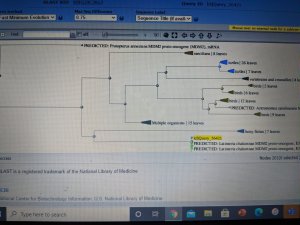Derf
Well-Known Member
- Aug 8, 2021
- 1,629
- 382
- 62
- Country
- United States
- Gender
- Male
- Faith
- Christian
- Marital Status
- Married
- Politics
- US-Republican
I would suggest that you try the other viewpoints with as much enthusiasm for their presuppositions, as you exhibit for yours. From all the research I've seen (and I'll admit I haven't been keeping up with it in the last few years as much as I did before), the DNA phylogenies have as much trouble crossing barriers between kinds of animals as the fossil record seems to show. I guess in that way, they are in agreement.When we come to realize that these orders are a 1-1 match, the conclusion is that the fossil succession matches DNA because the fossil record is a product of DNA+Time. And if common descent is true, then Adam must have existed in a certain window of time in which the phylogenies align in suggesting that He did.
This is actually quite a good analogy, because it presumes knowledge of a beginning and an analysis point, it presumes the same players that started the game are still at it (including some that started on the bench), as well as rules of the game--at least that's what a baseball analogy would presume. Maybe you're talking about a different game and you just call it baseball. Your analogy is a good demonstration of the creation of all things on earth and in the heavens at a point in time, and some progression in and out of the game of types of creatures that were in existence from the beginning.It's like saying that in a baseball game, in the 2nd inning if a team had 5 points, and then in the 8th inning the team had 7 points, then the only conclusion is that some time between the 2nd and 8th inning, they must have had a score of 6. If all ancestral species were reptiles in the carboniferous and mankind exists today (as observed in phylogenies), then Adam would have been between the carboniferous and today. Which post dates death observed in Cambrian Burgess shake species.
The evolutionary model lacks knowledge of the beginning, it assumes players that weren't in the game (or even on the bench) are now in the game, and the rules change depending on the findings of the spectators.
I can assure you that I'm sympathetic to the YEC model, but I'm not sold on all aspects of it. I'm not sympathetic at all to the theistic evolution model, if one could even be imagined, because it presumes that science, which is constantly changing, is correct and Genesis is only correct when it matches up with science--a pretty hard target for an active website today, much more so for a book written 3.5 thousand years ago.That's an overly technical answer for a question that most people would never ask. Most people are either YECs or theistic evolutionists, but your question comes from a perspective in between, a position that few people have.
However, the bible has shown itself to be much more stable in its story in other scientific fields, like archeology, surpassing the accuracy of the science itself in predictions. It has at least as much predictive capacity for biology as it does for archeology, and the strength of those predictions isn't waning with time, though science's are (since it is constantly changing).
A quick example is that science predicted that DNA was mostly vestigial or random junk. Now science recognizes that most DNA has function.
There are other examples, but DNA is particularly applicable, since you have an affinity for what it can tell us of the past--you would want your story to be as stable as possible for the predictive power to be useful.
Upvote
0


